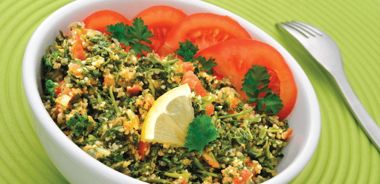Tabbouleh

Tabbouleh is a traditional Arabic salad made with bulgur and a selection of finely chopped vegetables. If cutting all the vegetables seems daunting, pull out the food processor and make use of its chopping blade.
Salad1 cup (250 mL) medium bulgur 1 cup (250 mL) boiling water 2 large tomatoes, finely chopped 1 red pepper, seeded, finely chopped 1 cup (250 mL) cucumber, finely diced 1/2 cup (125 mL) green onions, minced 1/4 cup (60 mL) fresh mint, minced 1/2 cup (125 mL) fresh parsley, minced
Dressing2 Tbsp (30 mL) cold-pressed, extra-virgin olive oil 1/2 cup (125 mL) lemon juice 2 cloves garlic, minced Salt and pepper to taste
Put bulgur in medium bowl, add boiling water; cover and let sit until grain is tender and all water is absorbed. Cool cooked grain in refrigerator. While grains cool, make dressing by whisking together olive oil, lemon juice, garlic, and salt and pepper. Complete salad by combining cooled bulgur and remaining vegetables in large salad bowl. Pour dressing over salad and toss well. Serves 6.
Each serving contains: 165 calories; 5 g protein; 5.2 g total fat (0.7 g sat. fat, 0 g trans fat); 29 g carbohydrates; 5 g fibre; 20 mg sodium
source: "Give Grains a Chance", alive #321, July 2009




